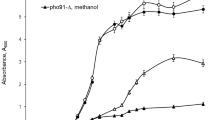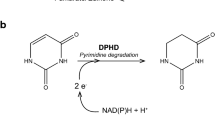Abstract
We have isolated several mutants ofSaccharomyces cerevisiae that are sensitive to oxidative stress in a screen for elevated sensitivity to hydrogen peroxide. Two of the sixteen complementation groups obtained correspond to structural genes encoding enzymes of the pentose phosphate pathway. Allelism of thepos10 mutation (POS forperoxidesensitivity) to thezwf1/met1 mutants in the structural gene for glucose 6-phosphate dehydrogenase was reported previously. The second mutation,pos18, was complemented by transformation with a yeast genomic library. The open reading frame of the isolated gene encodes 238 amino acids. No detectable ribulose 5-phosphate epimerase activity was found in thepos18 mutant, suggesting that the corresponding structural gene is affected in this mutant. For that reason the gene was renamedRPE1 (forribulose 5-phosphateepimerase).RPE1 was localized to chromosome X. The predicted protein has a molecular mass of 25 966 Daltons, a codon adaptation index (CAI) of 0.32, and an isoelectric point of 5.82. Database searches revealed 32 to 37% identity with ribulose 5-phosphate epimerases ofEscherichia coli, Rhodospirillum rubrum, Alcaligenes eutrophus andSolanum tuberosum. We have characterizedRPE1 by testing enzyme activities inrpe1 deletion mutants and in strains that overexpressRPE1, and compared the hydrogen peroxide sensitivity ofrpe1 mutants to that of other mutants in the pentose phosphate pathway. Interestingly, all mutants tested (glucose 6-phosphate dehydrogenase, gluconate 6-phosphate dehydrogenase, ribulose 5-phosphate epimerase, transketolase, transaldolase) are sensitive to hydrogen peroxide.
Similar content being viewed by others
References
Altschul SF, Gish W, Miller W, Myers EW, Lipman DJ (1990) Basic local alignment search tool. J Mol Biol 215:403–410
Ausubel FM, Brent R, Kingston RE, Moore DD, Seidmann JG, Smith JA, Struhl K (ed.) (1987) Current protocols in molecular biology. John Wiley and Sons, New York
Belazzi T, Wagner A, Wiesner R, Schanz M, Adam G, Harting A, Ruis H (1991) Negative regulation of transcription of theSaccharomyces cerevisiae catalase T (CTT1) gene by cAMP is mediated by a positive control element. EMBO J 10:585–592
Bergmeyer HU (1983) Methoden der enzymatischen Analyse. Verlag Chemie, Weinheim
Bermingham-McDonogh O, Gralla EB, Valentine JS (1988) The copper, zinc-superoxide dismutase gene ofSaccharomyces cerevisiae: cloning, sequencing, and biological activity. Proc Natl Acad Sci USA 85:4789–4793
Blattner FR, Burland V, Plunkett III G, Sofia HJ, Daniels DL (1993) Analysis of theEscherichia coli genome. IV. DNA sequence of the region from 89.2 to 92.8 minutes. Nucleic Acids Res 21:5408–5417
Buettner GR (1993) The pecking order of free radicals and anti-oxidants: lipid peroxidation, tocopherol and ascrobate. Arch Biochem Biophys 300:535–543
Chae HZ, Chung SJ, Rhee SG (1994) Thioredoxin-dependent peroxide reductase from yeast. J Biol Chem 269:27670–27678
Ciriacy M (1975) Genetics of alcohol dehydrogenase inSaccharomyces cerevisiae. Isolation and genetic analysis of mutants. Mutat Res 29:315–326
Cohen SS (1955) Gluconokinase. Methods Enzymol 1:350–354
Cohen G, Fessl F, Traczyk A, Rytka J, Ruis H (1985) Isolation of the catalase A gene ofSaccharomyces cerevisiae by complementation of thecta1 mutation. Mol Gen Genet 200:74–79
Ellman GL (1959) Tissue sulfhydryl groups. Arch Biochem Biophys 82:70–77
Epp O, Ladenstein R, Wendel A (1983) The refined structure of the selenoenzyme glutathione peroxidase at 0.2 nm resolution. Eur J Biochem 133:51–69
Falcone DL, Tabita FR (1993) Complementation analysis and regulation of CO2 fixation gene expression in a ribulose 1,5-bisphosphate carboxylase-oxygenase deletion strain ofRhodospirillum rubrum. J Bacteriol 175:5066–5077
Farr SB, Kogoma T (1991) Oxidative stress responses inEscherichia coli andSalmonella typhimurium. Microbiol Rev 55:561–585
Fridovich L (1978) The biology of oxygen radicals. The superoxide radical is an agent of oxygen toxicity; superoxide dismutase provides an important defense. Science 201:875–880
Gaetani GF, Mareni C, Salvidio E, Galiano S, Meloni T, Arese P (1979) Favism: erythrocyte metabolism during haemolysis and reticulocytosis. Brit J Haematol 43:39–48
Gardner PR, Fridovich I (1993) NADPH inhibits transcription of theEscherichia coli manganese superoxide dismutase gene (sodA) in vitro. J Biol Chem 268:12958–12963
Gietz RD, Sugino A (1988) New yeast-Escherichia coli shuttle vectors constructed with in vitro mutagenized yeast genes lacking six-base pair restriction sites. Gene 74:527–534
Gutteridge JMC, Halliwell B (1990) The measurement and mechanism of lipid peroxidation in biological systems. Trends Biochem Sci 15:129–135
Haber F, Weiss J (1934) Proc Roy Soc Lond (Ser A) 147:332–351
Hoffman CS, Winston F (1987) A ten-minute DNA preparation from yeast efficiently releases autonomous plasmids for transformation ofEscherichia coli. Gene 57:267–272
Hunt JC, Phibbs PV Jr (1983) Regulation of alternate peripheral pathways of glucose catabolism during aerobic and anaerobic growth ofPseudomonas aeruginosa. J Bacterial 154:793–802
Imlay JA, Linn S (1988) DNA damage and oxygen radical toxicity. Science 240:1302–1309
Izawa S, Inoue Y, Kimura A (1995) Oxidative stress response in yeast: effect of glutathione on adaptation to hydrogen peroxide stress inSaccharomyces cerevisiae. FEBS Lett 368:73–76
Kirkman HN, Gaetani GD, Clemons EH, Mareni C (1975) Red cell NADP+ and NADPH in glucose 6-phosphate dehydrogenase deficiency. J Clin Invest 55:875–878
Klebe RJ, Harriss JV, Sharp D, Douglas MG (1983) A general method for polyethylene glycol-induced transformation of bacteria and yeast. Gene 25:333–341
Krems B, Charizanis C, Entian K-D (1995) Mutants ofSaccharomyces cerevisiae sensitive to oxidative and osmotic stress. Curr Genet 27:427–434
Krems B, Charizanis C, Entian K-D (1996) The response regulator-like protein Pos9/Skn7 ofSaccharomyces cerevisiae is involved in oxidative stress resistance. Curr Genet 29:327–334
Kusian B, Yoo J-G, Bednarski R, Bowien B (1992) The Calvin cycle enzyme pentose-5-phosphate 3-epimerase is encoded within thecfx operons of the chemoautotrophAlcaligenes eutrophus. J Bacteriol 174:7337–7344
Maitra PK (1971) Glucose and fructose metabolism in a phosphoglucoseisomerase-less mutant ofSaccharomyces cerevisiae. J Bacteriol 107:759–769
Mareni C, Gaetani GF (1976) NADP+ and NADPH in glucose 6-phosphate dehydrogenase-deficient erythrocytes under oxidative stimulation. Biochim Biophys Acta 430:395–398
Meister A (1983) Selective modification of glutathione metabolism. Science 220:472–477
Meister A, Anderson ME (1983) Glutathione. Annu Rev Biochem 52:711–760
Micheli V, Simmons HA, Bari M, Pompucci G (1993) HPLC determination of oxidized and reduced pyridine coenzymes in human erythrocytes. Clin Chim Acta 220:1–17
Moody CS, Hassan HM (1982) Mutangenicity of oxygen free radicals. Proc Natl Acad Sci USA 79:2855–2859
Niederacher D, Entian K-D (1987) Isolation and characterization of the regulatoryHEX2 gene necessary for glucose repression in yeast. Mol Gen Genet 206:505–509
Nogae I, Johnston M (1990) Isolation and characterization of theZWF1 gene ofSaccharomyces cerevisiae, encoding glucose 6-phosphate dehydrogenase. Gene 96:161–169
Novello F, McLean P (1968) The pentose phosphate pathway of glucose. Biol J 107:775–791
Pandolfi PP, Sonati F, Rivi R, Mason P, Grosveld F, Luzzatto L (1995) Targeted disruption of the housekeeping gene encoding glucose 6-phosphate dehydrogenase (G6PD): G6PD is despensable for pentose synthesis but essential for defense against oxidative stress. EMBO J 14:5209–5215
Pearson WR, Lipman DJ (1988) Improved tools for biological sequence comparison. Proc Natl Acad Sci USA 85:2444–2448
Sambrook J, Fritsch EF, Maniatis T (1989) Molecular cloning: a laboratory manual (2nd edn) Cold Spring Harbor Laboratory Press, Cold Spring Harbor, New York
Sanger F, Nicklen S, Coulson AR (1977) DNA sequencing with chain-termination inhibitors. Proc. Natl Acad Sci USA 74:5463–5467
Schaaff I, Hohmann S, Zimmermann FK (1990) Molecular analysis of the structural gene for yeast transaldolase. Eur J Biochem 188:597–603
Schaaff-Gerstenschläger I, Mannhaupt G, Vetter I, Zimmermann FK, Feldmann H (1993) TKL2, a second transketolase gene ofSaccharomyces cerevisiae. Cloning, sequence and deletion analysis of the gene. Eur J Biochem 217:487–492
Schaaff-Gerstenschläger I, Zimmermann FK (1993) Pentose-phosphate pathway inSaccharomyces cerevisiae: analysis of deletion mutants for transketolase, transaldolase, and glucose 6-phosphate dehydrogenase. Curr Genet 24:373–376
Shreve DS, Holloway MP, Haggerty JC, Sable HZ (1983) The catalytic mechanism of transketolase. Thiamine- and pyrophosphate-derived transition states for transketolase and pyruvate dehydrogenase are not identical. J Biol Chem 258:12405–12408
Sinha A, Maitra PK (1992) Induction of specific enzymes of the oxidative pentose phosphate pathway by glucono-lactone inSaccharomyces cerevisiae. J Gen Microbiol 138:1865–1873
Steels EL, Learmonth RP, Watson K (1994) Stress tolerance and membrane lipid unsaturation inSaccharomyces cerevisiae grown aerobically or anaerobically. Microbiology 140:569–576
Storz G, Tartaglia LA, Farr SB, Ames BN (1990) Bacterial defenses against oxidative stress. Trends Genet 6:363–368
Sundström M, Lindqvist Y, Schneider G, Hellman U, Ronne H (1993) Yeast TKL1 gene encodes a transketolase that is required for efficient glycolysis and biosynthesis of aromatic amino acids. J Biol Chem 268:24346–24352
Teige M, Kopriva S, Bauwe H, Suess K (1995). Molecular cloning and sequencing of pentose-5-phosphate-3-epimerase from potato. Accession No. Z50098
Thomas D, Cherest H, Surdin-Kerjan Y (1991) Identification of the structural gene for glucose 6-phosphate dehydrogenase in yeast. Inactivation leads to a nutritional requirement for organic sulfur. EMBO J 10:547–553
Tietze F (1969) Enzymatic method for quantitative determination of nanogram amounts of total and oxidized glutathione: applications to mammalian blood and other tissues. Anal Biochem 27:502–522
Tsai CS, Ye HG, Shi JL (1995a) Carbon-13 NMR studies and purification of gluconate pathway enzymes fromSchizosaccharomyces pombe. Arch Biochem Biophys 316:155–162
Tsai CS, Shi JL, Ye HG (1995b) Kinetic studies of gluconate pathway enzymes fromSchizosaccharomyces pombe. Arch Biochem Biophys 316:163–168
Voss H, Benes V, Andrade MA, Valencia A, Rechmann S, Teodoru C, Schwager C, Paces V, Sander C, Ansorge W (1996) DNA sequencing and analysis of 130 kilobases from yeast chromosome XV, Yeast, in press
Westerbeek-Marres CAM, Moore MM, Autor AP (1988) Regulation of manganese superoxide dismutase inSaccharomyces cerevisiae. the role of respiratory chain activity. Eur J Biochem 174:611–620
Whiting PH, Midgley M, Dawes EA (1976) The role of glucose limitation in the regulation of the transport of glucose, gluconate and 2-oxogluconate, and of glucose metabolism inPseudomonas aeruginosa. J Gen Microbiol 92:304–310
Zamenhoff S (1957) Preparation and assay of deoxyribonucleic acids from animal tissue. Methods Enzymol 3:696–704
Zitomer R, Lowry CV (1992) Regulation of gene expression by oxygen inSaccharomyces cerevisiae. Microbiol Rev 56:1–11
Author information
Authors and Affiliations
Additional information
Communicated by C. P. Hollenberg
Rights and permissions
About this article
Cite this article
Juhnke, H., Krems, B., Kötter, P. et al. Mutants that show increased sensitivity to hydrogen peroxide reveal an important role for the pentose phosphate pathway in protection of yeast against oxidative stress. Molec. Gen. Genet. 252, 456–464 (1996). https://doi.org/10.1007/BF02173011
Received:
Accepted:
Issue Date:
DOI: https://doi.org/10.1007/BF02173011




